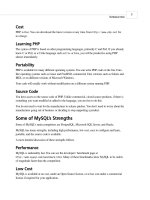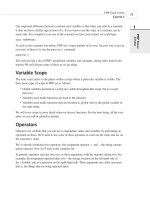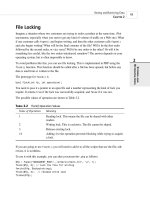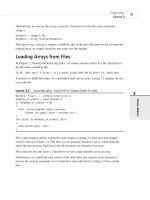Phát triển web với PHP và MySQL - p 28 pot
Bạn đang xem bản rút gọn của tài liệu. Xem và tải ngay bản đầy đủ của tài liệu tại đây (521.9 KB, 10 trang )
CHAPTER
11
Advanced MySQL
14 7842 CH11 3/6/01 3:35 PM Page 245
Using MySQL
P
ART II
246
In this chapter, we’ll cover some more advanced MySQL topics including advanced privileges,
security, and optimization.
The topics we’ll cover are
• Understanding the privilege system in detail
• Making your MySQL database secure
• Getting more information about databases
• Speeding things up with indexes
• Optimization tips
• Different table types
Understanding the Privilege System in Detail
Previously (in Chapter 8, “Creating Your Web Database”) we looked at setting up users and
granting them privileges. We did this with the GRANT command. If you’re going to administer a
MySQL database, it can be useful to understand exactly what GRANT does and how it works.
When you issue a GRANT statement, it affects tables in the special database called mysql.
Privilege information is stored in five tables in this database. Given this, when granting privi-
leges on databases, you should be cautious about granting access to the mysql database.
One side note is that the GRANT command is only available from MySQL version 3.22.11
onward.
We can look at what’s in the mysql database by logging in as an administrator and typing
use mysql;
If you do this, you can then view the tables in this database by typing
show tables;
as usual.
The results you get will look something like this:
+ +
| Tables in mysql |
+ +
| columns_priv |
| db |
| host |
| tables_priv |
| user |
+ +
14 7842 CH11 3/6/01 3:35 PM Page 246
Each of these tables stores information about privileges. They are sometimes called grant
tables. These tables vary in their specific function but all serve the same general function,
which is to determine what users are and are not allowed to do. Each of them contains two
types of fields: scope fields, which identify the user, host, and part of a database; and privilege
fields, which identify which actions can be performed by that user in that scope.
The user table is used to decide whether a user can connect to the MySQL server and whether
she has any administrator privileges. The db and host tables determine which databases the
user can access. The tables_priv table determines which tables within a database a user can
use, and the columns_priv table determines which columns within tables they have access to.
The user Table
This table contains details of global user privileges. It determines whether a user is allowed to
connect to the MySQL server at all, and whether she has any global level privileges; that is,
privileges that apply to every database in the system.
We can see the structure of this table by issuing a
describe user; statement.
The schema for the user table is shown in Table 11.1.
TABLE 11.1 Schema of the user Table in the mysql Database
Field Type
Host char(60)
User char(16)
Password char(16)
Select_priv enum(‘N’,’Y’)
Insert_priv enum(‘N’,’Y’)
Update_priv enum(‘N’,’Y’)
Delete_priv enum(‘N’,’Y’)
Create_priv enum(‘N’,’Y’)
Drop_priv enum(‘N’,’Y’)
Reload_priv enum(‘N’,’Y’)
Shutdown_priv enum(‘N’,’Y’)
Process_priv enum(‘N’,’Y’)
File_priv enum(‘N’,’Y’)
Grant_priv enum(‘N’,’Y’)
References_priv enum(‘N’,’Y’)
Index_priv enum(‘N’,’Y’)
Alter_priv enum(’N’,’Y’)
Advanced MySQL
C
HAPTER 11
11
ADVANCED
MY
SQL
247
14 7842 CH11 3/6/01 3:35 PM Page 247
Each row in this table corresponds to a set of privileges for a user coming from a host and log-
ging in with the password Password. These are the scope fields for this table, as they describe
the scope of the other fields, called privilege fields.
The privileges listed in this table (and the others to follow) correspond to the privileges we
granted using GRANT in Chapter 8. For example, Select_priv corresponds to the privilege to run
a SELECT command.
If a user has a particular privilege, the value in that column will be Y. Conversely, if a user has
not been granted that privilege, the value will be N.
All the privileges listed in the user table are global, that is, they apply to all the databases in
the system (including the mysql database). Administrators will therefore have some Ys in there,
but the majority of users should have all
Ns. Normal users should have rights to appropriate
databases, not all tables.
The db and host Tables
Most of your average users’ privileges are stored in the tables db and host.
The db table determines which users can access which databases from which hosts. The privi-
leges listed in this table apply to whichever database is named in a particular row.
The host table supplements the db table. If a user is to connect to a database from multiple
hosts, no host will be listed for that user in the db table. Instead, she will have a set of entries
in the host table, one to specify the privileges for each user-host combination.
The schemas of these two tables are shown in Tables 11.2 and 11.3, respectively.
TABLE 11.2 Schema of the db Table in the mysql Database
Field Type
Host char(60)
Db char(64)
User char(16)
Select_priv enum(‘N’,’Y’)
Insert_priv enum(‘N’,’Y’)
Update_priv enum(‘N’,’Y’)
Delete_priv enum(‘N’,’Y’)
Create_priv enum(‘N’,’Y’)
Drop_priv enum(‘N’,’Y’)
Using MySQL
P
ART II
248
14 7842 CH11 3/6/01 3:35 PM Page 248
Grant_priv enum(‘N’,’Y’)
References_priv enum(‘N’,’Y’)
Index_priv enum(‘N’,’Y’)
Alter_priv enum(’N’,’Y’)
TABLE 11.3 Schema of the host Table in the mysql database
Field Type
Host char(60)
Db char(64)
Select_priv enum(‘N’,’Y’)
Insert_priv enum(‘N’,’Y’)
Update_priv enum(‘N’,’Y’)
Delete_priv enum(‘N’,’Y’)
Create_priv enum(‘N’,’Y’)
Drop_priv enum(‘N’,’Y’)
Grant_priv enum(‘N’,’Y’)
References_priv enum(‘N’,’Y’)
Index_priv enum(‘N’,’Y’)
Alter_priv enum (‘N’,’Y’)
The tables_priv and columns_priv Tables
These two tables are used to store table-level privileges and column-level privileges, respec-
tively. They work like the db table, except that they provide privileges for tables within a spe-
cific database and columns within a specific table respectively.
These tables have a slightly different structure to the user, db, and host tables. The schemas
for the tables_priv table and the columns_priv table are shown in Tables 11.4 and 11.5,
respectively.
Advanced MySQL
C
HAPTER 11
11
ADVANCED
MY
SQL
249
TABLE 11.2 Continued
Field Type
14 7842 CH11 3/6/01 3:35 PM Page 249
TABLE 11.4 Schema of the tables_priv Table in the mysql Database
Field Type
Host char(60)
Db char(64)
User char(16)
Table_name char(64)
Grantor char(77)
Timestamp timestamp(14)
Table_priv set(‘Select’, ‘Insert’, ‘Update’, ‘Delete’, ‘Create’, ‘Drop’,
‘Grant’, ‘References’, ‘Index’, ‘Alter’)
Column_priv set(‘Select’, ‘Insert’, ‘Update’, ‘References’)
TABLE 11.5 Schema of the columns_priv Table in the mysql Database
Field Type
Host char(60)
Db char(60)
User char(16)
Table_name char(60)
Column_name char(59)
Timestamp timestamp(14)
Column_priv set(‘Select’, ’Insert’, ‘Update’, ‘References’)
The Grantor column in the tables_priv table stores the user who granted this privilege to this
user. The Timestamp column in both these tables stores the date and time when the privilege
was granted.
Access Control: How MySQL Uses the Grant Tables
MySQL uses the grant tables to determine what a user is allowed to do in a two-stage process:
1. Connection verification. Here, MySQL checks whether you are allowed to connect at all,
based on information from the user table, as shown previously. This is based on your
username, hostname, and password. If a username is blank, it matches all users.
Hostnames can be specified with a wildcard character (%). This can be used as the entire
field—that is, % matches all hosts—or as part of a hostname, for example,
%.tangledweb.com.au matches all hosts ending in .tangledweb.com.au. If the password
Using MySQL
P
ART II
250
14 7842 CH11 3/6/01 3:35 PM Page 250
field is blank, then no password is required. It’s more secure to avoid having blank users,
wildcards in hosts, and users without passwords.
2. Request verification. Each time you enter a request, after you have established a connec-
tion, MySQL checks whether you have the appropriate level of privileges to perform that
request. The system begins by checking your global privileges (in the user table) and if
they are not sufficient, checks the db and host tables. If you still don’t have sufficient
privileges, MySQL will check the tables_priv table, and, if this is not enough, finally it
will check the columns_priv table.
Updating Privileges: When Do Changes Take Effect?
The MySQL server automatically reads the grant tables when it is started, and when you issue
GRANT and REVOKE statements.
However, now that we know where and how those privileges are stored, we can alter them
manually. When you update them manually, the MySQL server will not notice that they have
changed.
You need to point out to the server that a change has occurred, and there are three ways you
can do this. You can type
FLUSH PRIVILEGES;
at the MySQL prompt (you will need to be logged in as an administrator to do this). This is the
most commonly used way of updating the privileges.
Alternatively you can run either
mysqladmin flush-privileges
or
mysqladmin reload
from your operating system.
After this, global level privileges will be checked the next time a user connects; database privi-
leges will be checked when the next use statement is issued; and table and column level privi-
leges will be checked on a user’s next request.
Making Your MySQL Database Secure
Security is important, especially when you begin connecting your MySQL database to your
Web site. In this section, we’ll look at the precautions you ought to take to protect your data-
base.
Advanced MySQL
C
HAPTER 11
11
ADVANCED
MY
SQL
251
14 7842 CH11 3/6/01 3:35 PM Page 251
MySQL from the Operating System’s Point of View
It’s a bad idea to run the MySQL server (mysqld) as root if you are running a UNIX-like oper-
ating system. This gives a MySQL user with a full set of privileges the right to read and write
files anywhere in the operating system. This is an important point, easily overlooked, which
was famously used to hack Apache’s Web site. (Fortunately the crackers were “white hats”
[good guys], and the only action they took was to tighten up security.)
It’s a good idea to set up a MySQL user specifically for this purpose. In addition, you can then
make the directories (where the physical data is stored) accessible only by the MySQL user. In
many installations, the server is set up to run as userid mysql, in the mysql group.
You should also ideally set up your MySQL server behind your firewall. This way you can stop
connections from unauthorized machines—check and see whether you can connect from out-
side to your server on port number 3306. This is the default port that MySQL runs on, and
should be closed on your firewall.
Passwords
Make sure that all your users have passwords (especially root!) and that these are well chosen
and regularly changed, as with operating system passwords. The basic rule to remember here is
that passwords that are or contain words from a dictionary are a bad idea. Combinations of let-
ters and numbers are best.
If you are going to store passwords in script files, then make sure only the user whose pass-
word is stored can see that script. The two main places this can arise are
1. In the mysql.server script, you might need to use the UNIX root password. If this is the
case, make sure only root can read this script.
2. In PHP scripts that are used to connect to the database, you will need to store the pass-
word for that user. This can be done securely by putting the login and password in a file
called, for example, dbconnect.php, that you then include when required. This script can
be stored outside the Web document tree and made accessible only to the appropriate
user. Remember that if you put these details in a .inc or some other extension file in the
Web tree, you must be careful to check that your Web server knows these files must be
interpreted as PHP so that the details cannot be viewed in a Web browser.
Don’t store passwords in plain text in your database. MySQL passwords are not stored that
way, but commonly in Web applications you additionally want to store Web site member’s
login names and passwords. You can encrypt passwords (one-way) using MySQL’s PASSWORD()
or MD5() functions. Remember that if you INSERT a password in one of these formats when
you run a SELECT (to try and log a user in), you will need to use the same function again to
check the password a user has typed.
Using MySQL
P
ART II
252
14 7842 CH11 3/6/01 3:35 PM Page 252
We will use this functionality when we come to implement the projects in Part 5, “Building
Practical PHP and MySQL Projects.”
User Privileges
Knowledge is power. Make sure that you understand MySQL’s privilege system, and the con-
sequences of granting particular privileges. Don’t grant more privileges to any user than she
needs. You should check this by looking at the grant tables.
In particular, don’t grant the PROCESS, FILE, SHUTDOWN, and RELOAD privileges to any user other
than an administrator unless absolutely necessary. The
PROCESS privilege can be used to see
what other users are doing and typing, including their passwords. The
FILE privilege can be
used to read and write files to and from the operating system (including, say, /etc/password
on a UNIX system).
The
GRANT privilege should also be granted with caution as this allows users to share their priv-
ileges with others.
Make sure that when you set up users, you only grant them access from the hosts that they will
be connecting from. If you have jane@localhost as a user, that’s fine, but plain jane is pretty
common and could log in from anywhere—and she might not be the jane you think she is.
Avoid using wildcards in hostnames for similar reasons.
You can further increase security by using IPs rather than domain names in your host table.
This avoids problems with errors or crackers at your DNS. You can enforce this by starting the
MySQL daemon with the skip-name-resolve option, which means that all host column val-
ues must be either IP addresses or localhost.
Another alternative is to start mysqld with the secure option. This checks resolved IPs to
see whether they resolve back to the hostname provided. (This is on by default from version
3.22 onward.)
You should also prevent non-administrative users from having access to the
mysqladmin pro-
gram on your Web server. Because this runs from the command line, it is an issue of operating
system privilege.
Web Issues
When you connect your MySQL database to the Web, it raises some special security issues.
It’s not a bad idea to start by setting up a special user just for the purpose of Web connections.
This way you can give them the minimum privilege necessary and not grant, for example,
DROP, ALTER, or CREATE privileges to that user. You might grant SELECT only on catalog tables,
and INSERT only on order tables. Again, this is an illustration of how to use the principle of
least privilege.
Advanced MySQL
C
HAPTER 11
11
ADVANCED
MY
SQL
253
14 7842 CH11 3/6/01 3:35 PM Page 253
You should always check all data coming in from a user. Even if your HTML form consisted
of select boxes and radio buttons, someone might alter the URL to try to crack your script. It’s
also worth checking the size of the incoming data.
If users are typing in passwords or confidential data to be stored in your database, remember
that it will be transmitted from the browser to the server in plaintext unless you use SSL
(Secure Sockets Layer). We’ll discuss using SSL in more detail later.
Getting More Information About Databases
So far, we’ve used SHOW and DESCRIBE to find out what tables are in the database and what
columns are in them. We’ll briefly look at how else they can be used, and at the use of the
EXPLAIN statement to get more information about how a SELECT is performed.
Getting Information with SHOW
Previously we had used
SHOW TABLES;
to get a list of tables in the database.
The statement
show databases;
will display a list of available databases. You can then use the SHOW TABLES statement to see a
list of tables in one of those databases:
show tables from books;
When you use SHOW TABLES without specifying a database, it defaults to the one in use.
When you know what the tables are, you can get a list of the columns:
show columns from orders from books;
Using MySQL
P
ART II
254
We talked in the last chapter about using PHP’s addslashes() and stripslashes()
functions to get rid of any problematic characters in strings. It’s important to remem-
ber to do this, and to do a general data clean up before sending anything to MySQL.
You might remember that we used the
doubleval() function to check that the
numeric data was really numeric. It’s a common error to forget this—people remem-
ber to use
addslashes() but not to check numeric data.
CAUTION
14 7842 CH11 3/6/01 3:35 PM Page 254









